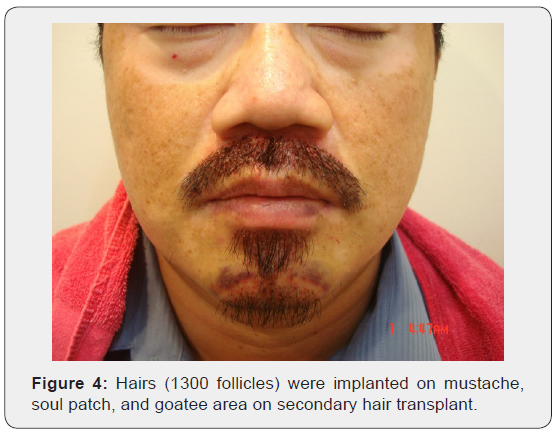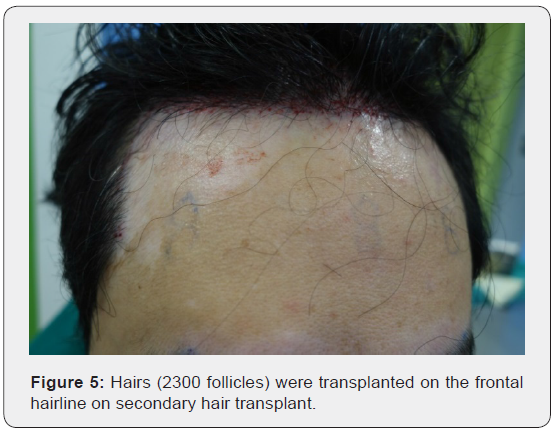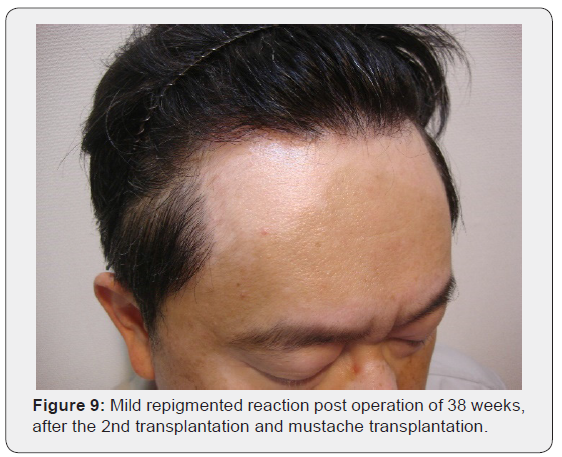Juniper Publishers- Open Access Journal of Case Studies
Hair Transplant on Hairline and Mustache of Asian Male Affected by Vitiligo: A Case Report
Authored by Yi Jung Lin
Abstract
Hair transplantation has been used to repigment stable vitiligo patients. Skin depigmentation of vitiligo is a suffering and distressing cosmetic imperfections. Several therapeutic options including photochemotherapy and corticosteroids application are available for the treatment of repigmentation, the development of these therapies are time consuming and process duplicated, still not fully satisfying. There are some reports for hair transplantation applied on body vitiligo of hairy or non-glabrous area. In this paper, the authors presented a case of Asian man with facial depigmentation who tried hairline and mustache implanting to reduce the facial area of depigmentation and still transplanted melanocytes to skin around depigmentation. Under the design and creativity of facial hair implantation, the face with localized depigmentation can be polished more desirable and follicle melanocytes implanted around for this patient.
Keywords:Hair transplant; Hairline transplant; Mustache transplant; Vitiligo; Follicle melanocyte
Introduction
Vitiligo is an attained idiopathic depigmentary melanocytopenic dermatosis, which is challenging to treat through combined therapy including topical/systemic immunosuppressive, phototherapy, excimer laser, surgery, etc. [1]. Although triggering simple cosmetic damage, vitiligo leads to unequal psychosocial distress, mostly in the Asian population for obvious skin color contrast [2]. Vitiligo has been treated with various surgical modalities including hair transplantation with moveable success rates. Body hair transplantation aids in repigmentation by perifollicular spread of melanocyte and stem cells from the implanted follicles. Moreover, the new hair also restores the aesthetic appearance. This type of implantation is active in focal vitiligo.
Body hair transplantation aids in repigmentation by perifollicular spread of melanocyte and stem cells from the implanted follicles. Moreover, the new hair also restores the aesthetic appearance. This type of implantation is active in focal vitiligo. Case Report
Case Report
A 46-year-old Male patient came to our clinic two years ago for hair transplantation due to mid-scalp hair loss and frontal temporal recession. He was noted with skin depigmentation on forehead (on the right was much more than the left), periorbital, and perioral areas at that time. There was no sign of vitiligo for the past 5 or 6 years. We performed 3500 hair transplantation for him on anterior frontal-temporal site and mid-scalp. After hair transplantation, he favored from very mild repigmented reaction around the border of hairline transplantation. Therefore, he came last year for the 2nd time transplantation to remedy of his vitiligo appearance.
Under careful observation, the obvious depigmented area with few leukotrichia was evident in a large triangle beneath the right frontal temporal angle about the size of 7cm X 6cm, but not distinct on the left side. In addition, the periorbital and the perioral depigmented patches are located around the eyes, on the upper lip, bilateral mouth angle and soul patch. After discussion, we decided to perform hair transplantation on the frontal hairline and mustache this time. As for the periorbital area, we saved it for next time. We performed 2300 hairs on his hairline, temporal peak and 1300 hairs on his mustache, soul patch, and goatee this time. No phototherapy was applied after hair transplantation.
The challenging target on the to-do-list
Non-hairy area: The patient still grieves from the depigmented places around his periorbital area. How we take the next steps to stimulate the melanocyte migration from follicle implant. Despite researchers are reported about the implantation of upper two thirds of hair follicles on depigmented area, to obtain the confident results still need more case reports to support physicians and patients to work on it.


Through facial hair transplantation, we are able to change the contour of facial frame and features as well as improve the depigmented imperfection. We applied the techniques and concepts of aesthetic implantation to patch the negative appearance of vitiligo and still repigmented the area around implanted hair follicles. There is still challenging target for us to work on the non-hairy area of segmented hair follicles in the future.


Discussion
Various surgical techniques are experienced for treating stable vitiligo patches, e.g. punch graft, Thiersch’s graft, blister-graft, full-thickness skin graft, autologous melanocyte transplants, in vitro cultured epidermal grafts bearing melanocytes, and micropigmentation all these techniques tempt satisfactory repigmentation with some disadvantages.
Na et al. [3] was introduced follicular unit transplant (FUT) for the purpose of repigmenting vitiligo patches [3]. This process is based on the perception of reality of homogenous stem cells in the hair follicle, which forms a good source of melanocytes for repigmentation. Cui et al. [4] suggested that repigmentation in vitiligo starts nearby the hair follicles because of the pool of melanocytes in the follicle [4]. There are two types of active and inactive melanocytes in hair follicle present, which creates a good source of melanocytes. In vitiligo, the active melanocytes are damaged, whereas the inactive ones are conserved, and hence these inactive melanocytes form the main source of repigmentation. Activated melanocytes can migrate to and repigment the adjacent epidermis [5]. Phototherapy-induced stimulation of melanocytes migration from the hair follicle reservoir is now a well-established fact [6]. Melanocytes extent centrifugally from the infundibulum to the basal layer and recolonize the epidermis with active and functional melanocytes [7]. Regardless of the mode of treatment, repigmentation in vitiligo usually begins in the perifollicular area.
Conclusion
Now it is a convenient way to improve the condition of stable vitiligo, especially the hair bearing areas. We could see the black hair regrowth on the depigmented area and mild repigmented reaction around the implanted area. There is an inflammatory cytokines stimulating follicular and perilesional melanocytes after transplantation. It is an effortless way for hair surgeon to improve the image of patient depigmented problem particularly near hairy area. The advantages of hair transplantation in this case we performed are as the following:
Coverage: We reduce the area of depigmented area, since the most depigmented area is beside the frontal temporal forehead.
Repigmented reaction: We could spot the repigmented reaction after hair transplantation especially on the upper lip, mouth angle and spirit spot.
To know more about Juniper Publishers please click on: https://juniperpublishers.com/manuscript-guidelines.php
For more articles in Open Access Journal of Case Studies please click on: https://juniperpublishers.com/jojcs/index.php




No comments:
Post a Comment